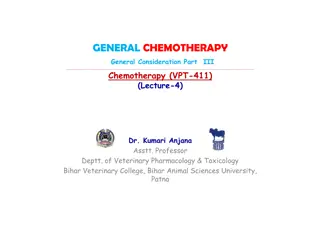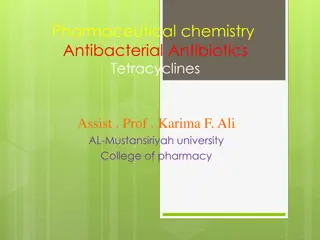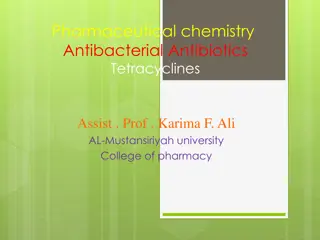Understanding Tetracyclines: Chemistry, History, and Applications
Tetracyclines are a group of natural and synthetic antibiotics with a unique chemical structure and broad-spectrum antimicrobial activity. They were first discovered through soil microorganism screening and have since become a cornerstone in modern chemotherapy. This chapter delves into their introduction, history, chemistry, and various applications in veterinary pharmacology, as well as discussing side effects and their diverse range of derivatives like doxycycline and minocycline.
Download Presentation

Please find below an Image/Link to download the presentation.
The content on the website is provided AS IS for your information and personal use only. It may not be sold, licensed, or shared on other websites without obtaining consent from the author. Download presentation by click this link. If you encounter any issues during the download, it is possible that the publisher has removed the file from their server.
E N D
Presentation Transcript
Tetracyclines Chemotherapy (VPT-411) (Lecture-14) Dr. Kumari Anjana Asstt. Professor Deptt. of Veterinary Pharmacology & Toxicology Bihar Veterinary College, Bihar Animal Sciences University, Patna
Content of the chapter Tetracyclines Introduction, History Source chemistry, classification spectrum of activity MOA Applications Side effects
Introduction Group of natural and semisynthetic antibiotics having nucleus of four partially unsaturated cyclohexane rings. All are obtained from soil actinomycetes and have nearly similar antimicrobial activity. All are crystalline yellow powder. Slightly water soluble but their hydrochloride salts are more soluble and are used (except doxycycline). It contrasted from penicillin G and streptomycin in being orally active and broad spectrum antibiotic.
History Tetracycline screening of soil microorganisms. antibiotics were produced by systemic The first member of the group was chlortetracycline. Derived aureofaciens introduced in 1948 under the name aureomycin (because of the golden colour of S. Aureofacience colonies producing it). from soil actinomycetes Streptomyces This was followed by oxytetracycline.
Removal of chlorine atom from chlortetracycline produced semisynthetic tetracycline introduced in 1952. Further discovery led to other semi-synthetic tetracycline's like Methacycline, Doxycycline, and Rolitetracycline. Doxycycline and minocycline are newer tetracyclines with high lipid solubility and longer duration of action.
Chemistry Tetracyclines are close congeners of polycyclic naphthacenecarboxamide. They are a family of four ringed amphoteric compounds that differ by specific substitutions at different points on the rings. As compounds, which in aqueous solution form salts with both acids and bases. a group, tetracyclines are acidic and hygroscopic
They ultraviolet light. characteristically fluoresce when exposed to Hydrochloride salts of tetracyclines are mostly used in clinics, except for doxycycline that is marketed as hyclate. Tetracyclines form insoluble chelate with divalent and trivalent cations like Ca++, Mg++, and Al+++.
Tetracyclines are stable as powders but their aqueous solutions are not stable. Therefore for parenteral injection, they are formulated in propylene glycol or polyvinyl pyrrolidine and stabilizers are added to increase stability and prolong elimination half-life. Physical and chemical properties of tetracyclines permit them to be formulated as injections, boluses, capsules, powders, feed additives, and ointments for veterinary use.
Classification Based on sources Natural: Chlortetracycline (streptomyces aureofaciens), Oxytetracycline (S. rimosus), Demethylchlortetracycline/demeclocycline (a mutant strain of S. aureofaciens). Semisynthetic: Tetracycline, methacycline, rolitetracycline, lymecycline, doxycycline and minocycline.
Based on duration of action Short acting: Tetracycline, Oxytetracycline and Chlortetracycline. Intermediate: Demeclocycline and Methacycline. Long acting: Doxycycline and Minocycline (highly protein bound and slowly excreted).
Mechanism of action The tetracyclines are primarily bacteriostatic; inhibit protein synthesis by binding to 30S ribosomes in susceptible organism. Subsequent to such binding, attachment of aminoacyl-t-RNA to the mRNA-ribosome complex is interfered. As a result, the peptide chain fails to grow. The sensitive organisms have an energy dependent active transport process which intracellularly. concentrates tetracyclines
In gram-negative bacteria tetracyclines diffuse through porin channels. The more lipid-soluble members (doxycycline, minocycline) enter by passive diffusion also (this is partly responsible for their higher potency). Two factors are responsible for the selective toxicity of tetracyclines for the microbes: oThe carrier involved in active transport of tetracyclines is absent in the host cell. oMoreover, protein synthesizing apparatus of host cell is less sensitive to tetracyclines.
Antibacterial spectrum Tetracyclines are broad spectrum antibiotics and practically inhibit all types of pathogenic mycobacteria, fungi and viruses. microorganism except Some strains of E. coli, Klebsiella, proteus, Psedomonas aeroginosa and Corynebacterium resistant to tetracyclines. spp. are frequently Therapeutically effective level in serum is 0.5 to 4 g / ml of serum.
Tetracyclines are active against: both aerobic and anaerobic Gram +ve and Gram -ve bacteria, Mycoplasma, Rickettsiae, Chlamidia and some protozoa like Babesia, Theileria, Anaplasma, Coccidia Entamoeba.
Pharmacokinetics Tetacyclines animals), parenterally (mostly IM and IV) and also topically. Absorption: Oral administration in carnivores the drugs are absorbed rapidly from GIT reaching peak plasma concentration within 2-4 hr which persists for 6-8 hr. are administered orally (mainly to small Milk and milk products, calcium, magnesium, iron or iron preparations and antacids interfere with the absorption of the tetracyclines in the GI tract due to chelation.
The absorption of doxycycline and minocycline is complete and highest in undergo enterohepatic cycling. Tetracycline should not be administered orally to ruminants as they are poorly absorbed and cause disruption of ruminal microflora. In veterinary medicine, specially buffered tetracycline solutions (to avoid irritation) administered by IM and sometimes by IV routes. are most commonly
IM dosage gives peak blood levels after 2 hr and maintained for 12-24 hr. Chlorteracycline should not be administered IM because of severe tissue irritation and damage. The long acting tetracycline are produced by delaying their absorption from IM sites by using a special carrier or increasing magnesium content. Oily preparations, used for SC administration in poultry should not be administered parenterally to mammals.
Distribution: Tetracyclines are widely and extensively distributed to almost all the body tissues and fluids, particularly after parenteral administration. These drugs undergo chelation with calcium and are deposited irreversibly in growing bones and teeth in young animals. Doxycycline and minocycline readily penetrate tissues and also CSF. protein binding varies from 30% (oxytetracycline) to 90% (doxycycline).
Metabolism : Tetracyclines undergo limited metabolism in domestic animals except doxycycline and minocycline (partly). Excretion: They are chiefly excreted by kidney via Glomerular filtration and also excreted unchanged in faeces directly or through bile. Most tetracyclines will accumulate if renal function is impaired and increases nephrotoxicity. Doxycycline is an exception as it is largely excreted through the GI tract. They are also secreted in milk. Their minimum therapeutic level is 0.5 to 1 g per ml serum.
Dosage Tetracycline and oxytertracycline: Dog & cat: 20 mg/kg orally at 12 hr intervals; 7-10 mg/kg/day IM or IV once day. Oxytertracycline: Calf, foal, lamb & pig: 10-20 mg/kg orally at 12 hr intervals; Horse,foal, cattle, calf sheep, lamb & pig: 5-10 mg/kg IM or IV once a day. Doxycycline: small animals: 5-10 mg/kg orally once a day; 5 mg/kg IM or IV once a day. Rolitetracycline: Cattle: 2 mg/kg IV once a day.
Withdrawal periods Oxytetracycline: cattle & pig: 22 days; poultry: 5days; Oxytetracycline (long acting): cattle-28 days; Chlortetracycline: cattle: 10 days; pig: 7 days; Oxytetracyclines are not to be used in lactating cows.
Clinical uses Tetracyclines are used in local infections viz. Mastitis (local + parenteral), Coliform-salmonella enteritis, Bronchopneumonia in all species, Urinary tract infections, Metritis, Pyodermatitis, Amoebiasis, Balantidosis, Leptospirosis, Cystitis in small animals and Specific disease actinomycosis Actinobacilosis, Keratoconjuntivitis, Brucellosis, Chlamydiosis, Babesiosis, Anaplasmosis, Theileriasis,
Rickettsiosis (especially chlortetracycline), Nocardiosis (especially minocycline), Ehrlichosis (especially doxycycline), Haermobartoneliosis, Pasteurellosis (transit fever, HS, fowl cholera) Bacterial diseases of poultry (blue comb in turkey,CRD contagious catarrh), to check secondary bacterial infection in viral infections.
Adverse Reactions and Toxicity Alteration in microflora in rumen or intestines oral use leads to digestive disturbances and ruminal stasis, decrease in synthesis and availability of vitamin B and K particularly in monogastric animals. Superinfections by fungi, yeasts and resistant bacteria may cause severe or fatal diarrhea (horse) following oral or parenteral administration.
Tetracyclines are deposited in growing teeth and bones and should not be used in growing animals because they cause yellowish and later brownish discoloration of teeth and suppress bone growth. Tetracycline should not be used with immunization programme (as they cause immunosuppression).
Intramammary contraindicated in dry cows (Cause severe tissue irritation and subsequent fibrosis) and if infused. Cows fail to lactate after parturition (due to teat and udder tissue damage). infusion of chlortetracycline is Intraarticular injection of tetracyclines are contraindicated (cause severe irritation and inflammation).
If administered by rapid IV injection, hypotension and acute collapse may occur in cattle and horses due to chelation of blood Ca++and this can be avoided by slow infusion of the drug or pretreatment with IV calcium gluconate. Tetracyclines in high doses produce hepatotoxicity particularly in pregnant animals or those having renal abnormality. All tetracyclines in high doses are potentially nephrotoxic (due to decrease in host protein synthesis and anti-anabolic effect) except doxycycline and are contraindicated in renal insufficiency.
Phototoxic dermatitis is most common with demeclocycline and doxycycline in man which is rare in animals. Hypersensitivity is rare. In human ingestion of outdated tetracyclines produces a syndrome characterized by aminoaciduria, glycosuria, polyuria and polydypsia due to proximal convoluted tubular damage (Fanconi syndrome). Demeclocycline induces diuresis (ADH antagonism).
Precautions Contraindicated in Pregnant, Lactating and Young animals. Must be cautiously used in animals with renal and hepatic dysfunctions. Injectable tetracyclines should penicillin (precipitation inactivation occurs). never be mixed with
Summary Tetracycline screening of soil microorganisms. They characteristically ultraviolet light. antibiotics were produced by systemic fluoresce when exposed to The protein synthesis by susceptible organism. Yellowish and later brownish discoloration of teeth and suppress bone growth. tetracyclines are primarily binding to 30S ribosomes in bacteriostatic; inhibit























